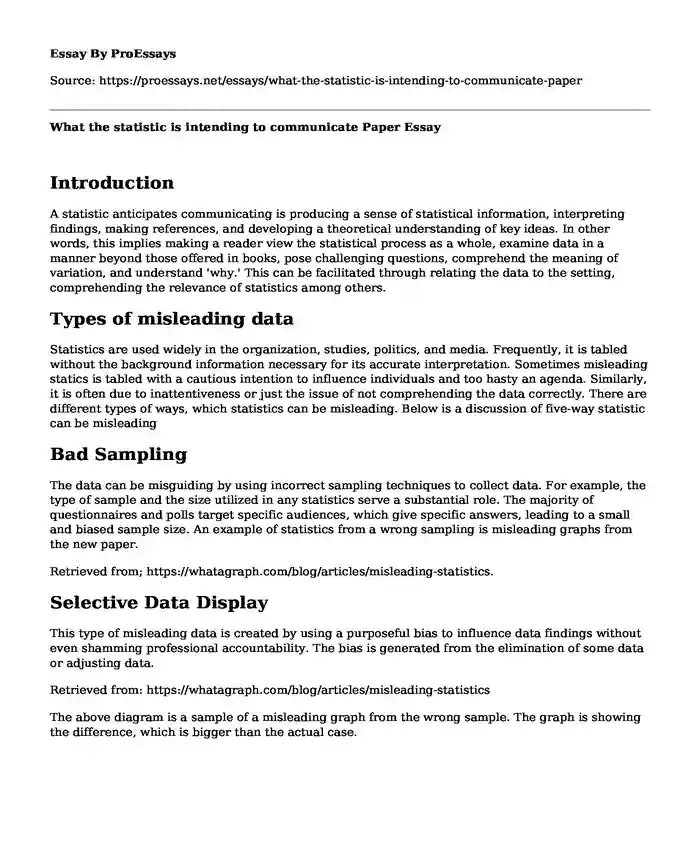Introduction
A statistic anticipates communicating is producing a sense of statistical information, interpreting findings, making references, and developing a theoretical understanding of key ideas. In other words, this implies making a reader view the statistical process as a whole, examine data in a manner beyond those offered in books, pose challenging questions, comprehend the meaning of variation, and understand 'why.' This can be facilitated through relating the data to the setting, comprehending the relevance of statistics among others.
Types of misleading data
Statistics are used widely in the organization, studies, politics, and media. Frequently, it is tabled without the background information necessary for its accurate interpretation. Sometimes misleading statics is tabled with a cautious intention to influence individuals and too hasty an agenda. Similarly, it is often due to inattentiveness or just the issue of not comprehending the data correctly. There are different types of ways, which statistics can be misleading. Below is a discussion of five-way statistic can be misleading
Bad Sampling
The data can be misguiding by using incorrect sampling techniques to collect data. For example, the type of sample and the size utilized in any statistics serve a substantial role. The majority of questionnaires and polls target specific audiences, which give specific answers, leading to a small and biased sample size. An example of statistics from a wrong sampling is misleading graphs from the new paper.
Retrieved from; https://whatagraph.com/blog/articles/misleading-statistics.
Selective Data Display
This type of misleading data is created by using a purposeful bias to influence data findings without even shamming professional accountability. The bias is generated from the elimination of some data or adjusting data.
Retrieved from: https://whatagraph.com/blog/articles/misleading-statistics
The above diagram is a sample of a misleading graph from the wrong sample. The graph is showing the difference, which is bigger than the actual case.
Omitting the Baseline
Another way one can recognize a misleading graph is through checking if it starts at zero rule has been employed. Normal graphs start at zero why X and Y divert. If the graphs at a value greater than zero, some data have been omitted.
Retrieved from: https://www.datapine.com/blog/misleading-data-visualization-examples
Prosecutor’s Fallacy
A persecutor to argue against a defender during court hearing can utilize this type of misleading statistics. Further, lawyers to prove the innocence of those they are representing can use it.
Retrieved from: https://www.klipfolio.com/blog/how-to-spot-misleading-data
Simpson’s Paradox
Simpson's paradox is when data shows a tendency when collected on dissimilar groups but reverses the tendency when it is joined in one group.
Retrieved from: https://towardsdatascience.com/simpsons-paradox-d2f4d8f08d42
How to correct the issue
When handling misleading data, it is important to locate the source of the problem. Once noticed, that is what a reader show be correcting to avoid working with misleading details. Technology can help one to identify and correct the error. If it is impossible or challenging to correct, one should look for a new set of data to use.
Cite this page
What the statistic is intending to communicate Paper. (2024, Jan 10). Retrieved from https://proessays.net/essays/what-the-statistic-is-intending-to-communicate-paper
If you are the original author of this essay and no longer wish to have it published on the ProEssays website, please click below to request its removal:
- Essay Example on the USA: A Rich Culture Marred by Racial Discrimination and Stereotyping
- Essay Example on Fairtrade Social Movement: Securing a Better Future for Coffee Farmers
- Essay Example on Matrilineal Societies: Asante Women Left Without Support
- Essay on Activism for Social Change: The Civil Rights, WLM & Gay Rights Movements
- Attachment Theory: Understanding the Parent-Child Bond Across Time & Space - Essay Sample
- Essay Example on Target's Data Security: Ensuring Trust and Safety
- Free Paper: Methods and Theories of Art History







